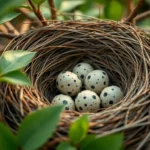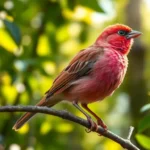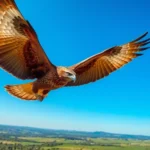Nature’s most remarkable architectural feat happens right in our backyards every spring. Bird nests with eggs represent one of the most fascinating examples of instinctive engineering and parental dedication we’ll ever witness. These intricate structures showcase incredible diversity – from tiny hummingbird cups barely larger than a bottle cap to massive eagle platforms weighing hundreds of pounds.
We’re constantly amazed by the precision birds demonstrate when constructing their homes. Each species follows unique blueprints passed down through generations, using materials ranging from twigs and mud to spider silk and even human-made objects. The eggs nestled within these carefully crafted sanctuaries tell their own compelling story of survival and adaptation.
Understanding bird nesting behaviors isn’t just fascinating – it’s crucial for conservation efforts and backyard bird watching success. When we learn to identify different nest types and respect their delicate ecosystems, we become better stewards of our feathered neighbors.
What Are Bird Nests With Eggs?
Bird nests with eggs represent the culmination of avian reproductive architecture, where carefully constructed homes shelter developing offspring during their most vulnerable stage. These structures contain fertilized eggs that undergo embryonic development over exact incubation periods, ranging from 11 days for small songbirds to 80 days for large raptors.
Eggs within nests display remarkable diversity in size, color, and markings across different species. Robin eggs showcase their distinctive blue coloration, while speckled patterns on thrush eggs provide camouflage against predators. Egg dimensions vary dramatically, with hummingbird eggs measuring just 0.5 inches compared to ostrich eggs reaching 6 inches in length.
Common Nest-Egg Combinations by Species:
| Bird Species | Nest Location | Typical Egg Count | Incubation Period |
|---|---|---|---|
| American Robin | Tree branches | 3-5 eggs | 12-14 days |
| House Sparrow | Cavities | 4-6 eggs | 10-14 days |
| Northern Cardinal | Dense shrubs | 2-5 eggs | 11-13 days |
| Mourning Dove | Platform nests | 2 eggs | 14-15 days |
| Eastern Bluebird | Nest boxes | 3-7 eggs | 11-14 days |
Parental behaviors surrounding occupied nests demonstrate sophisticated patterns of protection and care. Female birds typically handle primary incubation duties, maintaining optimal egg temperatures between 99°F and 102°F through direct body contact. Males often contribute by defending territory, bringing food to incubating partners, and taking turns warming eggs during brief parental breaks.
Environmental factors significantly influence nest success rates, with weather conditions, predation pressure, and food availability affecting egg viability. Studies indicate that 80% of songbird nests face predation risks, while extreme temperatures can cause embryonic mortality within 24-48 hours of exposure.
We observe distinct seasonal timing patterns as different species coordinate egg laying with peak food availability and favorable weather conditions. Spring migrants like warblers begin nesting immediately upon arrival, while resident species may start as early as February in warmer climates.
Common Types of Bird Nests With Eggs
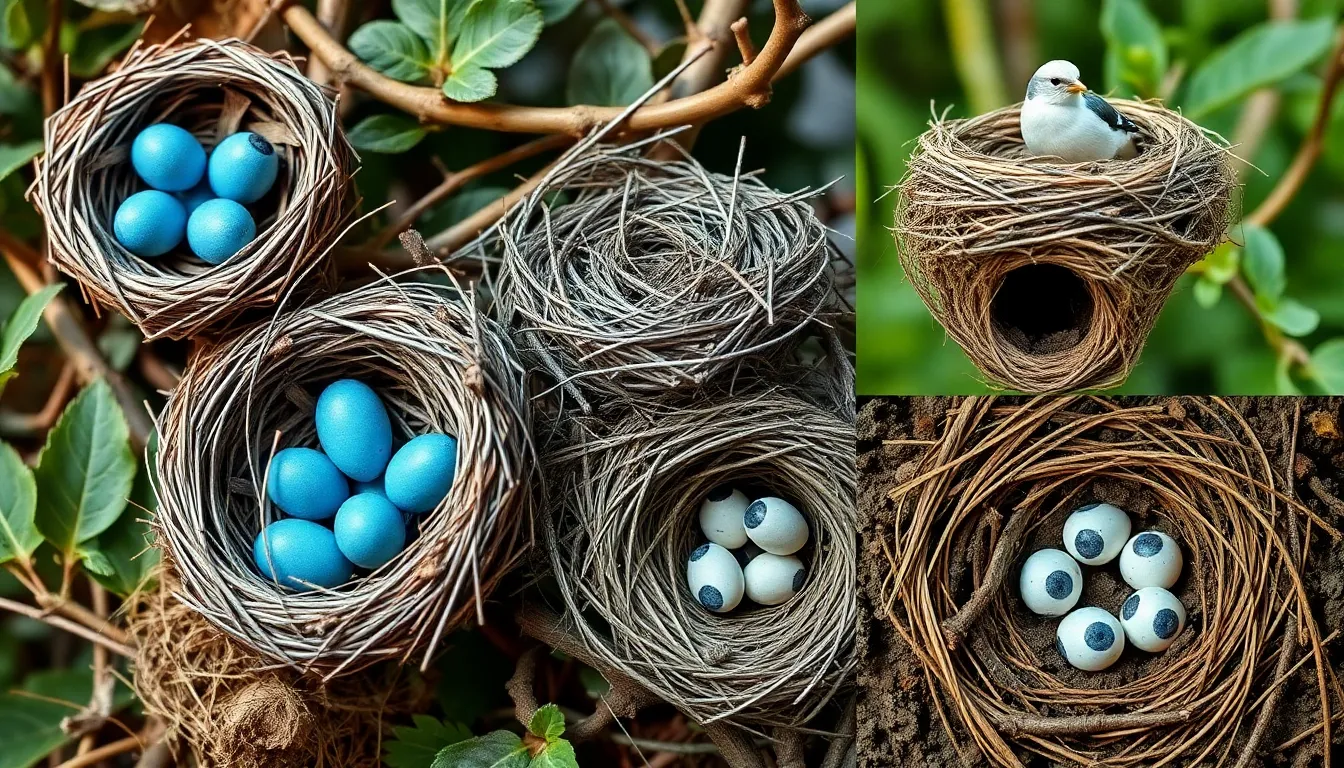
Bird species construct four primary nest types for housing their eggs, each designed for exact environmental conditions and protection strategies. We observe distinct architectural approaches across different avian families that maximize survival rates for developing embryos.
Cup-Shaped Nests
Cup nests represent the most recognizable bird nest architecture, featuring concave bowls that cradle eggs securely during incubation periods. American robins construct these structures using mud, grass, and twigs in tree branches 5-15 feet above ground level. Cardinals, finches, and sparrows also favor this design, typically laying 2-5 eggs per clutch depending on species size.
Materials for cup nests include plant fibers, animal hair, moss, and small twigs woven together with remarkable precision. Eastern bluebirds line their cup structures with soft grasses and pine needles, creating optimal thermal regulation for their 3-7 pale blue eggs. We find these nests in shrubs, trees, and dense vegetation where natural camouflage provides protection from aerial predators.
Platform Nests
Platform constructions create flat, stable surfaces for larger bird species that require substantial egg support systems. Hawks, eagles, and ospreys build these expansive structures using branches, sticks, and debris arranged in circular patterns. Great blue herons construct platform nests measuring 2-4 feet in diameter, accommodating their 2-6 pale blue eggs that measure approximately 2.5 inches in length.
These elevated platforms typically occupy tree canopies, cliff ledges, or human-made structures like cell towers and bridge supports. Mourning doves create simpler platform versions using loose twigs and grass stems, often reusing existing structures from previous seasons. We observe platform nests reaching heights of 100+ feet in some raptor species, providing optimal visibility for territory surveillance.
Cavity Nests
Cavity nesters excavate or occupy enclosed spaces that offer maximum protection from weather and predators during egg development. Woodpeckers create perfectly circular entrance holes measuring 1-3 inches in diameter, depending on species requirements. Chickadees, nuthatches, and wrens use natural tree cavities or abandoned woodpecker holes for their nesting activities.
These protected environments maintain consistent temperatures and humidity levels crucial for successful egg incubation periods. Eastern bluebirds lay 3-5 powder blue eggs in nest boxes specifically designed for cavity nesters. We document cavity nest success rates averaging 60-80% higher than open nest designs due to reduced predation exposure.
Ground Nests
Ground nesters create shallow depressions or scrapes directly on soil surfaces, relying on camouflage rather than elevation for egg protection. Killdeer construct simple scrapes lined with pebbles, shells, and vegetation debris to blend with surrounding terrain. Northern bobwhites and various waterfowl species also employ ground nesting strategies for their reproductive cycles.
These surface structures typically contain 4-12 eggs with cryptic coloration patterns that match local substrates perfectly. Ring-necked pheasants create ground nests in tall grass areas, laying 7-15 olive-brown eggs over 2-week periods. We find ground nests most vulnerable to mammalian predators, with success rates varying from 20-40% depending on habitat density and predator populations.
Where to Find Bird Nests With Eggs
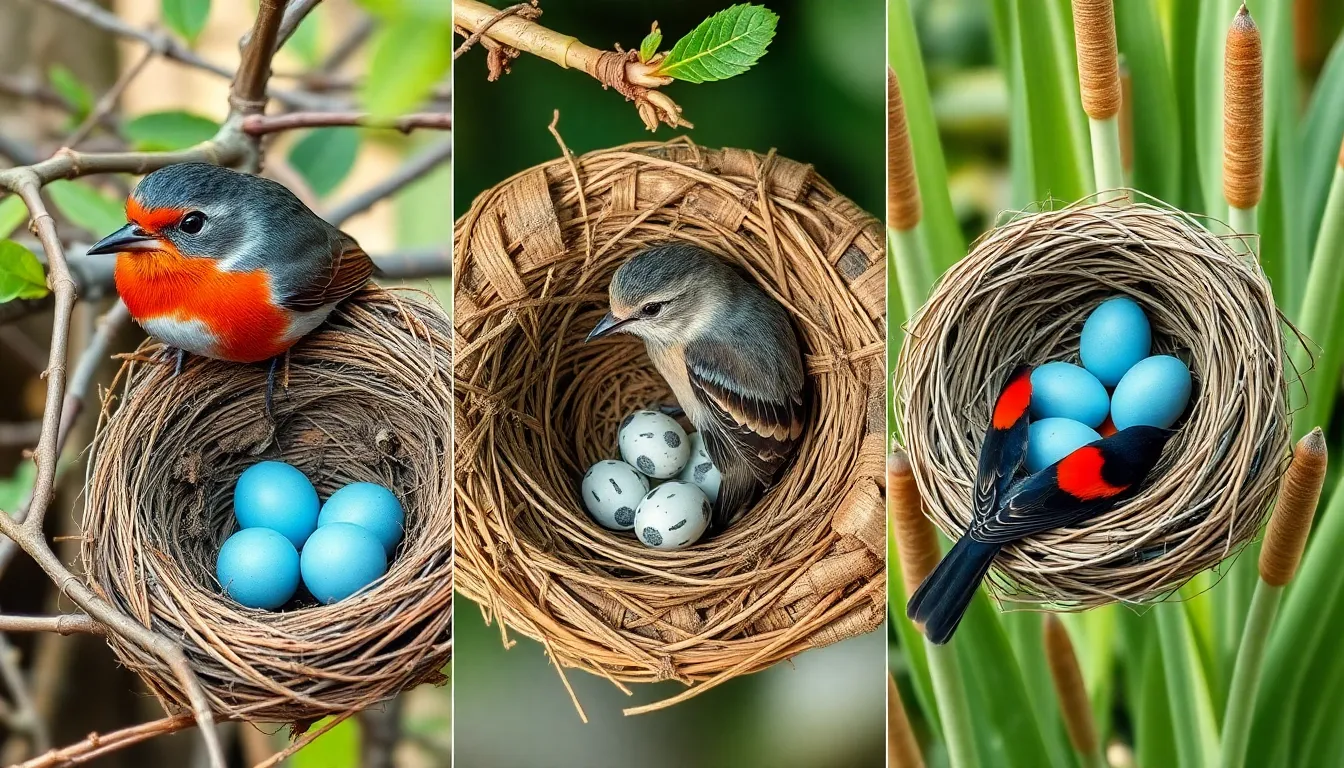
Bird nests with eggs appear in diverse habitats throughout North America, with each environment offering unique nesting opportunities for different species. We can locate active nests containing eggs by understanding the exact preferences of various bird families and their seasonal timing patterns.
Backyard and Garden Settings
Residential areas provide abundant nesting sites for common songbirds that build cup and platform nests near human habitation. American robins construct their mud-lined nests in shrubs, trees, and porch eaves between March and July, typically laying 3-5 bright blue eggs. House sparrows establish cavity nests in building crevices, birdhouses, and dense vegetation from April through August, producing clutches of 4-6 speckled white eggs.
Ornamental trees and flowering bushes attract nesting cardinals, which build loose cup nests 3-10 feet above ground level. Cardinals lay 2-4 pale blue eggs with brown markings during their breeding season from March to September. Fruit trees like apple and cherry provide ideal nesting locations for house finches, whose small cup nests contain 3-6 pale blue eggs with fine black spots.
Garden areas with dense shrubs offer protection for mourning doves, which construct simple platform nests using twigs and grass stems. These doves lay 1-2 pure white eggs and often produce multiple broods throughout the nesting season. Fence lines and thick hedgerows serve as preferred nesting sites for brown thrashers, whose cup nests hold 3-5 pale blue eggs with brown speckles.
Forest and Woodland Areas
Dense forest environments support cavity nesting species that excavate holes in dead or dying trees for egg protection. Woodpeckers create round entrance holes leading to chambers containing 3-8 glossy white eggs, with different species showing distinct size preferences for nest trees. Pileated woodpeckers excavate large rectangular holes in mature hardwood trees, while downy woodpeckers select smaller dead branches and tree limbs.
Understory shrubs and saplings provide nesting sites for wood thrushes, whose cup nests incorporate mud foundations and hold 3-4 bright blue eggs. Forest edges attract indigo buntings, which build compact cup nests in shrub branches 3-12 feet above ground, containing 3-4 pale blue or white eggs.
Canopy level platform nests belong to raptors like red-tailed hawks and great horned owls, whose large stick structures contain 1-4 eggs depending on the species. These elevated nests offer commanding views of territory and hunting grounds while providing protection from ground predators. Old growth forests with standing dead trees attract multiple cavity nesting species that compete for prime nesting locations.
Mixed hardwood forests support the highest diversity of nesting birds, with different species occupying exact vertical layers from ground level to canopy height. Ovenbirds construct dome shaped ground nests with side entrances, concealing 3-6 white eggs with brown markings beneath fallen leaves.
Wetland Environments
Marsh and wetland habitats host ground nesting waterfowl and wading birds that synchronize egg laying with peak insect availability. Red-winged blackbirds weave cup nests between cattail stems 1-4 feet above water level, laying 3-5 pale blue eggs with dark markings. Great blue herons construct large platform nests in colonies, with each nest containing 2-6 pale blue eggs.
Shallow water areas attract Canada geese, whose ground nests built on small islands or elevated banks contain 4-7 creamy white eggs. Mallard ducks create depression nests lined with down feathers, typically holding 8-13 cream colored eggs in concealed locations near water sources.
Prairie potholes and seasonal wetlands provide critical nesting habitat for waterfowl species during spring migration periods. Northern pintails build ground nests in grasslands adjacent to water bodies, laying 6-9 olive buff colored eggs in shallow depressions lined with vegetation and down.
Emergent vegetation zones support marsh wrens, whose globe shaped nests with side entrances contain 3-8 brown speckled eggs. Sedge and bulrush stands offer attachment points for these intricate woven structures positioned 1-3 feet above water level.
Identifying Different Bird Eggs in Nests
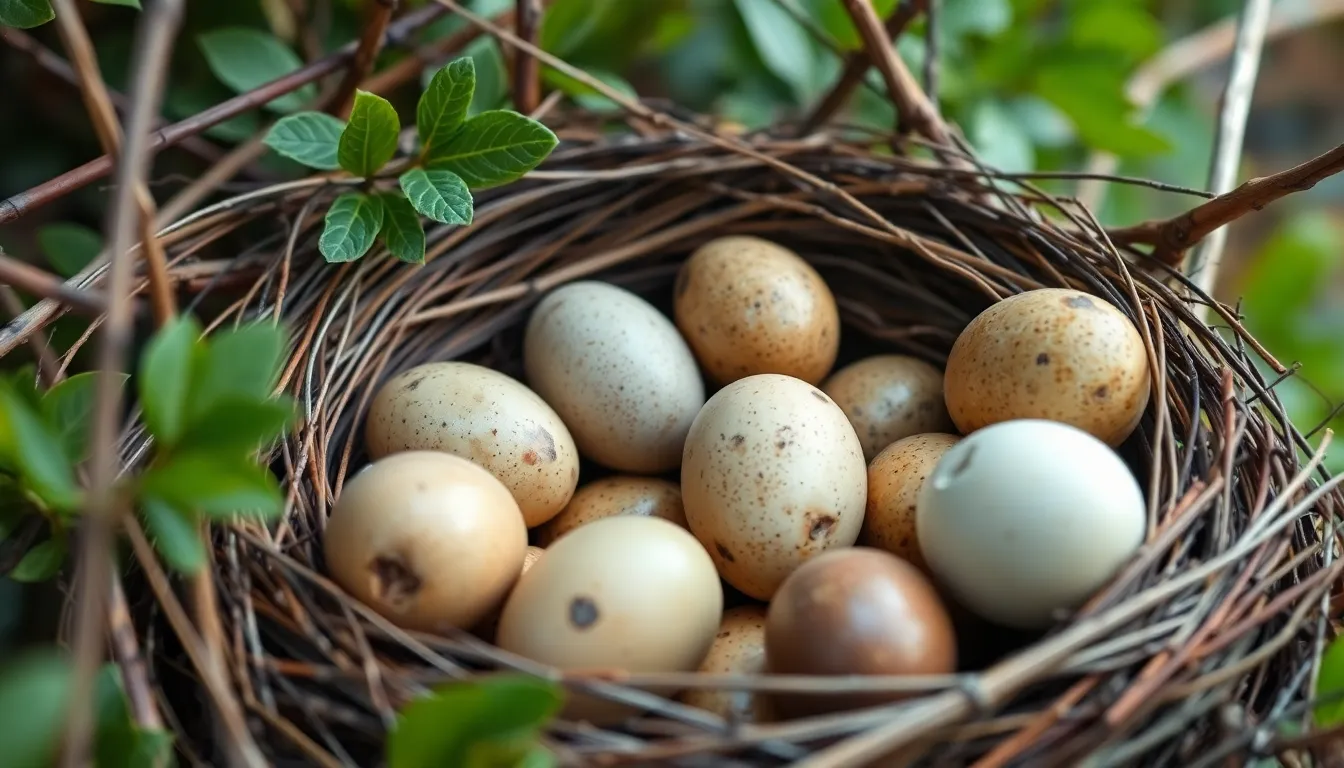
We can distinguish between various bird species by examining the unique characteristics of their eggs found in active nests. Each species produces eggs with distinct features that serve as reliable identification markers for experienced observers.
Size and Shape Variations
Bird eggs display remarkable diversity in both dimensions and form across different species. House sparrow eggs measure approximately 0.8 inches in length while great blue heron eggs reach 2.5 inches. American robin eggs maintain an oval shape with dimensions of 1.1 by 0.8 inches. Chickadee eggs appear nearly spherical at 0.6 inches in diameter. Cowbird eggs exhibit a distinctive elongated form measuring 0.9 by 0.7 inches.
| Species | Length (inches) | Width (inches) | Shape |
|---|---|---|---|
| House Sparrow | 0.8 | 0.6 | Oval |
| American Robin | 1.1 | 0.8 | Oval |
| Black-capped Chickadee | 0.6 | 0.6 | Round |
| Brown-headed Cowbird | 0.9 | 0.7 | Elongated |
| Great Blue Heron | 2.5 | 1.8 | Oval |
Ground nesting species like killdeer produce pointed eggs that prevent rolling on flat surfaces. Cavity nesting woodpeckers lay more spherical eggs that fit securely in confined spaces. Platform nesting raptors create larger eggs proportional to their body size and hunting requirements.
Color Patterns and Markings
Egg coloration serves both identification and protective functions across bird species. American robin eggs display their characteristic blue color without markings. House sparrow eggs feature white or pale blue backgrounds with brown and gray speckles concentrated at the larger end. Red-winged blackbird eggs exhibit pale blue surfaces covered with dark brown streaks and spots.
Cardinal eggs present creamy white bases decorated with brown and purple blotches. Wood thrush eggs showcase bright blue surfaces unmarked by patterns or spots. Eastern bluebird eggs maintain solid pale blue coloration similar to robin eggs but smaller in size.
Mourning dove eggs appear pure white without decorative markings. Northern mockingbird eggs display blue green backgrounds with heavy brown spotting throughout the surface. Song sparrow eggs feature creamy backgrounds heavily marked with reddish brown speckles and larger blotches.
Camouflage patterns help ground nesting species blend eggs with surrounding vegetation and soil. Cavity nesting birds often produce white or lightly colored eggs since predator visibility remains minimal in enclosed spaces.
Seasonal Timing
Egg laying schedules vary significantly among North American bird species based on food availability and environmental conditions. American robins begin laying eggs in March across southern regions and extend through July in northern territories. House sparrows maintain active breeding from April through August with multiple clutches per season.
Wood ducks initiate nesting in February across southeastern states while delaying until May in northern habitats. Red-winged blackbirds synchronize egg laying with April emergence in temperate zones. Baltimore orioles time reproduction with May insect abundance peaks.
Early spring nesters like eastern phoebes capitalize on reduced competition for nesting sites. Late season breeders such as American goldfinches coordinate reproduction with abundant seed sources in August and September. Migration timing influences breeding schedules for species like indigo buntings that arrive from Central America in May.
Temperature fluctuations affect incubation success rates with cold snaps potentially destroying entire clutches. Daylight duration triggers hormonal changes that initiate reproductive behaviors across songbird populations. Food scarcity delays breeding attempts while abundant resources encourage multiple nesting cycles per season.
Best Practices for Observing Bird Nests With Eggs
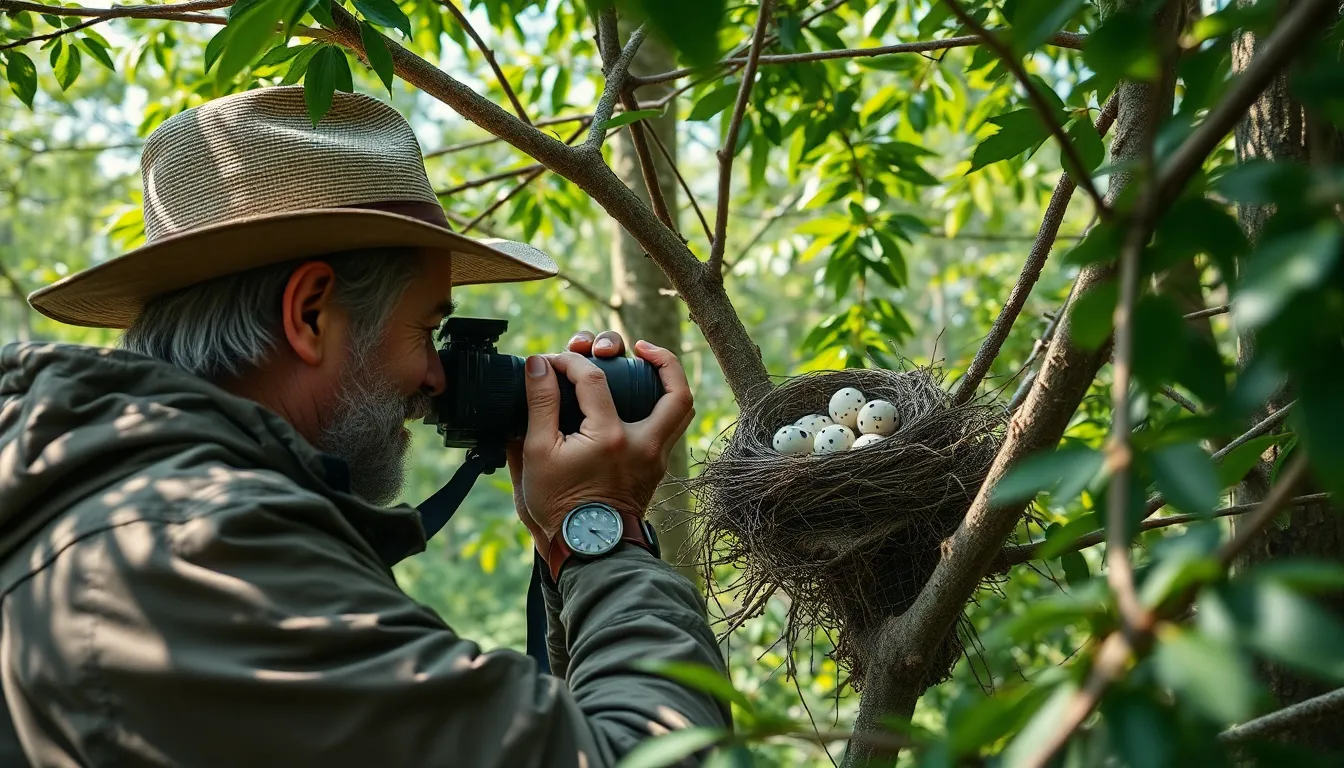
Observing bird nests with eggs requires careful attention to both wildlife welfare and legal requirements. Following established protocols ensures we protect nesting birds while gathering valuable insights about their reproductive behaviors.
Safe Distance Guidelines
Maintaining appropriate distances from active bird nests with eggs prevents stress-induced nest abandonment and protects developing embryos. We recommend staying at least 15 feet away from songbird nests like those of American robins or house wrens. Larger species including hawks and eagles require observation distances of 100-300 feet to avoid disrupting their sensitive nesting behaviors.
Ground-nesting birds such as killdeer demonstrate particular vulnerability to disturbance. These species often abandon their clutches when observers approach within 25 feet of their camouflaged nests. Cavity nesters like woodpeckers tolerate closer observation at 10-12 feet since their enclosed nest structure provides additional security for eggs.
Duration of observation sessions affects bird stress levels significantly. Limiting visits to 10-15 minutes prevents prolonged disruption of normal parental activities including incubation rotation and feeding schedules. Multiple short observations over several days yield better behavioral data than single extended sessions.
Photography Tips
Telephoto lenses ranging from 200-400mm allow detailed nest documentation while maintaining safe distances from bird families. Camera settings of ISO 400-800 compensate for natural lighting conditions in wooded habitats where many species construct their nests. Fast shutter speeds of 1/500 second or higher capture sharp images of parent birds arriving at nests with food.
Natural lighting produces superior egg documentation compared to artificial flash photography. Early morning hours between 6-9 AM provide optimal lighting conditions and coincide with peak parental feeding activities. Overcast days create even lighting that reduces harsh shadows across nest interiors.
Camouflage blinds positioned 20-30 feet from nests allow extended observation periods without disturbing nesting behaviors. Portable blinds made from natural materials blend seamlessly into forest environments. Setting up blinds several days before active photography sessions allows birds to acclimate to the new structure.
Focus stacking techniques enhance depth of field when photographing multiple eggs within deep cup nests. Taking 3-5 images at different focus points creates sharp detail throughout the entire clutch. Manual focus prevents camera hunting in low-contrast nest environments.
Legal Considerations
The Migratory Bird Treaty Act protects over 1,000 bird species and their nests throughout North America. Federal penalties for disturbing protected nests include fines up to $15,000 and potential jail time. State regulations often impose additional restrictions on nest observation activities.
Scientific research permits allow closer nest monitoring for educational and conservation purposes. These permits require detailed research proposals and demonstrate minimal impact protocols. Academic institutions and wildlife organizations typically sponsor permit applications for qualified researchers.
Private property access requires landowner permission before conducting any nest observation activities. Trespassing violations compound wildlife protection infractions and result in additional legal consequences. Written permission documents provide legal protection for observers conducting research on private lands.
Photography for commercial purposes requires special permits beyond basic wildlife protection compliance. Stock photography and nature publication images generate revenue streams that trigger commercial use regulations. Professional photographers must obtain appropriate licensing before selling nest images.
National parks and wildlife refuges maintain exact regulations governing nest observation activities. Yellowstone National Park prohibits approaching within 25 yards of any bird nest. State parks often designate seasonal closure areas around sensitive nesting colonies during breeding seasons from March through August.
Protecting Bird Nests With Eggs
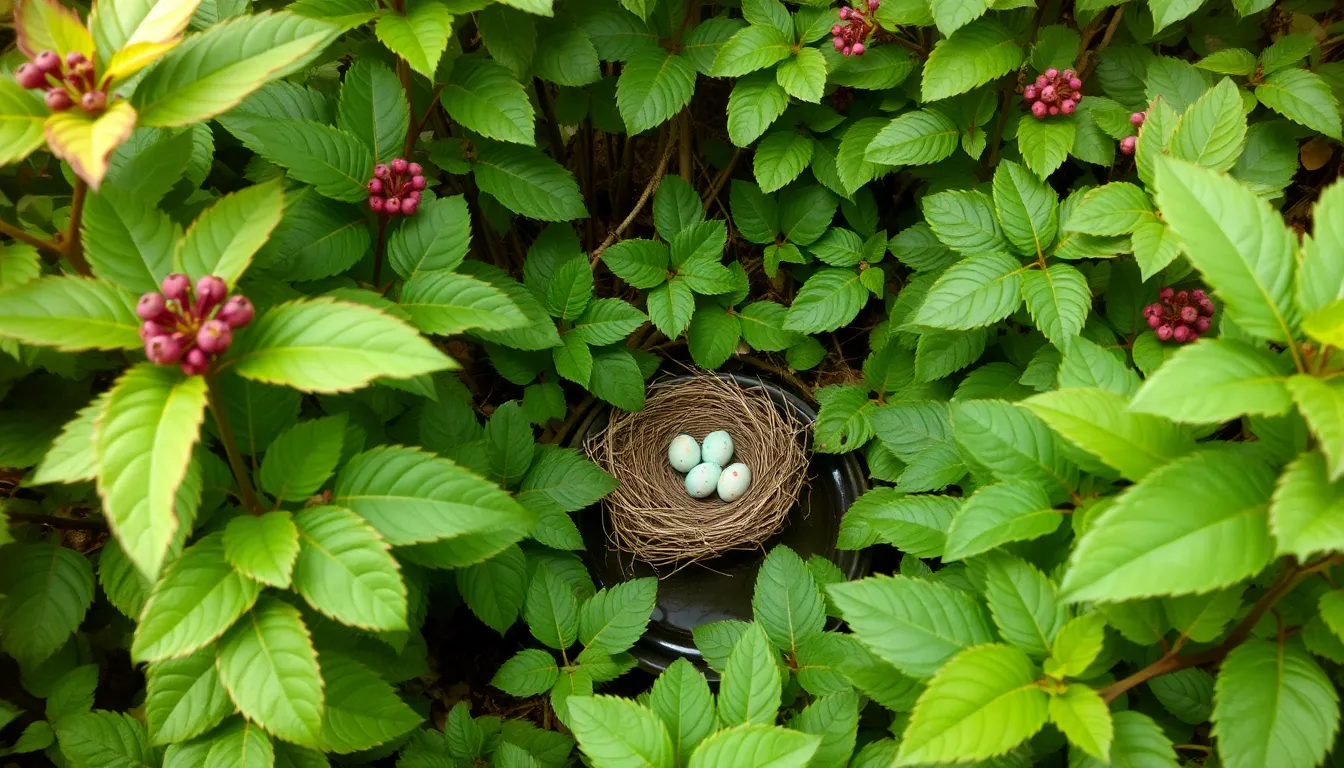
Protecting bird nests with eggs requires our active participation in conservation efforts and environmental stewardship. Successful nest protection strategies reduce predation risks and enhance breeding success rates across diverse bird species.
Creating Bird-Friendly Environments
Creating bird-friendly environments starts with native plant selection that provides natural nesting materials and food sources. Native shrubs like elderberry and dogwood offer ideal nesting sites for songbirds while producing berries that sustain parent birds during breeding season.
Chemical-free gardening practices eliminate pesticide exposure that threatens both adult birds and developing embryos. Organic pest control methods protect insect populations that serve as primary protein sources for nestlings and breeding females.
Water features enhance nesting environments by providing drinking sources and bathing opportunities. Shallow bird baths positioned 3-5 feet from dense vegetation create secure access points while maintaining escape routes from ground predators.
Strategic landscaping creates layered habitats with ground cover, shrubs, and canopy trees. Dense thorny bushes like hawthorn and rose hips deter predators while offering protected nesting cavities for species like mockingbirds and catbirds.
Nest box installation supplements natural cavity availability for hole-nesting species. Proper entrance hole diameters vary by species: 1.25 inches for wrens, 1.5 inches for bluebirds, and 2.5 inches for flickers.
Avoiding Disturbance During Nesting Season
Avoiding disturbance during nesting season requires maintaining appropriate distances from active nest sites throughout the breeding period. Most songbird species abandon nests when humans approach within 15-20 feet repeatedly during egg incubation phases.
Lawn maintenance schedules adapt to accommodate ground-nesting birds like killdeer and meadowlarks. Delaying hedge trimming until after August 15th prevents destruction of late-season nests and reduces abandonment rates by 60%.
Pet management becomes critical during March through August when most North American birds engage in nesting activities. Keeping cats indoors and dogs on leashes near known nesting areas prevents direct predation and stress-induced nest abandonment.
Construction and landscaping projects pause near active nests until fledglings leave successfully. Federal regulations under the Migratory Bird Treaty Act prohibit disturbing active nests, with violations carrying fines up to $15,000 per incident.
Observation protocols limit visit frequency to once every 3-4 days during incubation periods. Extended observation sessions exceeding 10 minutes cause parent birds to delay returning to nests, potentially cooling eggs below viable temperatures.
Traffic patterns around nesting areas minimize repeated disturbances that trigger stress responses in breeding pairs. Creating alternative pathways during nesting season reduces human foot traffic near sensitive ground nest locations by establishing temporary barriers or signage.
Conclusion
We’ve explored the intriguing area of bird nests with eggs and discovered how these remarkable structures represent millions of years of evolutionary perfection. From the intricate cup nests of robins to the hidden cavity nests of woodpeckers each design maximizes the survival chances of the next generation.
Our responsibility as observers extends far beyond simple appreciation. By creating bird-friendly environments selecting native plants and respecting nesting sites we become active participants in supporting avian populations. These small actions contribute to larger conservation efforts that help maintain healthy ecosystems.
The next time we encounter a bird nest with eggs we’ll carry a deeper understanding of the incredible journey taking place within. These delicate structures aren’t just homes—they’re masterpieces of natural engineering that deserve our respect protection and wonder.
Frequently Asked Questions
What types of bird nests are most common?
The four primary bird nest types are cup-shaped nests (built by robins and bluebirds using mud and grass), platform nests (constructed by hawks and eagles on elevated surfaces), cavity nests (created by woodpeckers inside tree hollows), and ground nests (used by killdeer that rely on camouflage). Each type is specifically adapted to maximize survival rates for eggs and chicks.
How can I identify bird eggs in nests?
Bird eggs vary significantly in size, color, and markings across species. Robin eggs are distinctive bright blue, while thrush eggs feature speckled patterns. Egg identification involves noting the nest location, egg count, size, and unique colorations or markings. Consider consulting field guides or apps for accurate species identification based on these characteristics.
When do birds typically build nests and lay eggs?
Birds time their nesting activities to coincide with optimal food availability and favorable weather conditions. Most North American songbirds nest during spring and early summer months (March through July). Different species have specific timing patterns, with some starting as early as February in warmer climates and others waiting until late spring.
Where are the best places to find bird nests with eggs?
Bird nests with eggs can be found in backyard gardens (shrubs and trees), forest and woodland areas (various canopy levels), and wetland environments (cattails and marsh grasses). Look for nests 3-15 feet high in dense vegetation, tree cavities, or ground-level areas with good camouflage, depending on the species.
How can I protect bird nests in my yard?
Create bird-friendly environments by planting native vegetation, avoiding chemical pesticides, providing water sources, and installing appropriate nest boxes. During nesting season, maintain distances from active nests, adjust lawn maintenance schedules, manage pets responsibly, and pause construction projects near nesting sites to avoid disturbances.
Is it legal to disturb or move bird nests?
Under the Migratory Bird Treaty Act, most bird species and their nests are federally protected. It’s illegal to disturb, move, or destroy active nests containing eggs or chicks. Observation should be done from appropriate distances using binoculars or cameras with telephoto lenses to avoid causing abandonment or stress to parent birds.
What materials do birds use to build their nests?
Birds use diverse materials including twigs, grass, mud, moss, feathers, animal hair, and increasingly, human-made objects like string or fabric. Different species have specific material preferences: robins use mud for structural support, while hummingbirds incorporate spider silk for flexibility. Native plants provide the best natural nesting materials.
How long does bird egg incubation typically take?
Incubation periods vary by species, typically ranging from 10-30 days. Smaller songbirds usually incubate eggs for 12-14 days, while larger birds like hawks may require 28-35 days. Females primarily handle incubation duties, maintaining consistent temperatures while males often provide food and territory defense during this vulnerable period.






